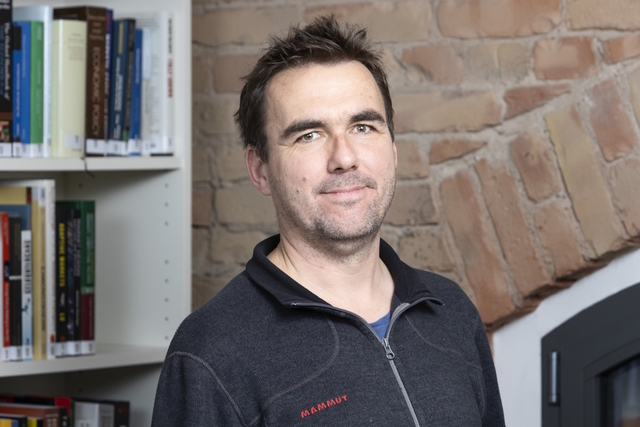Jan C. Minx, head of working group "Applied Sustainability Science" at MCC explains technologies as a means for removing carbon out of the atmosphere to keep global warming below the crucial 2°C.
The recent assessment by the Intergovernmental Panel on Climate Change (IPCC) reminded us that we are on a hard deadline to get our greenhouse gas emissions under control. In the news coverage following the report’s release there was a lot of discussion about carbon removal technologies — tech that would literally suck the CO2 out of the atmosphere.
But how does this technology work? And is it actually a viable option?
Professor Jan Christoph Minx, Head of working group "Applied Sustainability Science" at the Mercator Research Institute on Global Commons and Climate Change (MCC) and Chair in Climate Change and Public Policy at the Priestley International Centre for Climate has the answers:
1. With renewable energy initiatives growing all the time, why does CO2 removal remain important?
There are essentially two reasons why CO2 removal is important. First, the remaining net amount of CO2 that can be released into the atmosphere while still keeping global warming below 1.5°C is strictly limited and comparatively small. At current levels of global greenhouse gas emission we have 20-30 years at most before we exceed the 2°C limit.
The transformation towards a net-zero emissions economy will take time – remember we need to do this, in principle, in every single country around the globe. Because of this it is likely that we need to borrow some CO2 from the atmosphere. Hence, as with a bank loan, we emit more CO2 than our budget allows for in the short term and pay it back later with interest through carbon dioxide removal.
Second, it is unlikely that we will be able to remove every single greenhouse gas emission across the globe. Research widely shows that there will be come residual emissions that could be too hard to mitigate – for example, methane from cattle ranging, nitrous oxide from fertilizer use or CO2 in the transport sector. These will need to be compensated by CO2 removal activities.
2. Could you explain how carbon dioxide removal technologies work?
Carbon dioxide removal refers to a spectrum of technologies that suck CO2 out of the atmosphere.
They include relatively simple options like planting more trees to lock up CO2 as they grow, or crushing rocks that naturally absorb CO2 and spreading them on soils so that they remove CO2 more rapidly.
A further option involves burning plants for energy and capturing the CO2 that would otherwise be released, then storing it permanently deep below the ground. This is called bioenergy with carbon capture and storage.
Another option includes using chemicals to sequester CO2 from the air, what we refer to as direct air capture.
SASK POWER Boundary Dam Power Station in Estevan, Canada, Photo: SASK POWER
3. What are the benefits of the direct air capture method of CO2 removal when compared with other approaches?
Direct air capture (DAC) uses chemical processes to absorb CO2 from the atmosphere. The CO2 is then stored underground in geological reservoirs or in long-life products such as concrete, chemicals or other building materials.
Compared to other CO2 removal methods DAC does not require much land and it can, in principle, be placed anywhere – as long as there is access to geological storage and sufficient energy.
4. What can be done with the CO2 that is removed from the air?
In modelling studies most of the CO2 is geologically stored. However, the first commercial DAC plants sell the CO2 on. Greenhouses for example are in the market for CO2 as it helps to accelerate plant growth.
While this does not lead to a permanent removal of CO2 from the atmosphere, generating revenues in niche markets is crucial for these start-ups and the further development of the technology.
5. Is there a possibility that carbon removal will make efforts to reduce our carbon emissions take a backseat?
Well, I do not believe that discussions around CO2 removal so far have deterred countries from reducing emissions. CO2 removal is a science-led discussion that has not reached the centre of climate policy yet – particularly at the international level.
But could it do so? Quite possibly. Once CO2 removal technologies become a viable topic of international climate policy discussion, there would be new possibilities and risks for renegotiating international sharing of the C02 burden.
For example, if industrialized countries start using carbon dioxide removal technologies to achieve negative emission targets at the national level this could cause them to contest the need to fully live up to their historical responsibility. Those kind of negotiations may stall mitigation action. But nobody knows how this will influence negotiations.
From a scientific perspective it is clear: sustained and rapid global emission reductions and the accelerated research and diffusion on CO2 removal technologies cannot be a contradiction. Otherwise, in my view, we will not have a chance to meet the international climate targets.
6. Is the direct air capture of CO2 commercially viable? And are the costs for this type of technology likely to come down in the future?
There are different DAC pathways – some of them are very expensive, energy-intensive and unlikely to be viable.
However, DAC pathways that have made it into larger demonstrations or commercial applications are less energy intensive. As a direct consequence, costs of DAC has been plummeting much faster than people would have expected 10 years ago – when most people thought that this tech was another wild dream of engineers and chemists against the laws of thermodynamics.
Do not get me wrong – DAC is not cheap yet. But we expect substantial future cost reductions over the next couple of decades.
7. Does CO2 capture receive enough support and funding from investors and public bodies?
This is not for researchers to decide. We need carbon removal for achieving the international climate goals, but what technologies we choose for that needs to result from a discourse of their costs, potentials and side-effects once deployed at scale.
What I can also say is that we are really lagging behind with the development and roll-out of CO2 removal technologies compared to what we see in many climate change mitigation scenarios.
While we are seeing a burst of new scientific literature on this tech, the overwhelming majority focuses on early-stage research. But bringing new technologies to widespread adoption typically requires a sequence of activities beyond research and development, such as demonstration projects and serving niche markets, followed by a gradual process of scaling up to a larger market.
In fact, if we apply the time scale it has taken for solar PV to become low cost and apply them to DAC, we will not provide the technology at scale in time to be relevant for climate change. We, therefore, need to think more actively about speeding up innovation for CO2 removal technologies. This is something the Washington Post and the Carbon Brief have discussed.
Climate-smart soils: CIAT is testing soil health in Western Kenya, Photo: CIAT
8. Why hasn’t this technology been scaled up commercially already?
There were no real incentives to do so. We need to put a price on carbon for CO2 removal technologies to be developed.
I hear people saying that we need a new Manhattan or Apollo Project: just throw money at it until we have the technologies. This is not going to work here. The Manhattan and Apollo Projects had to create a few individual tangible outputs: rockets, nuclear bombs and satellites. Here we are probably talking about hundreds or thousands of operational plants. We need markets for that.
9. Do carbon capture costs differ depending on what industry it is applied to? (Eg coal, gas, steel, fertiliser, etc)
They do - but the single biggest difference in carbon capture costs is whether this is done from ambient air - air in the atmosphere - or gas streams with high concentrations of CO2, for example from a power plant.
10. What is the future likely to hold for the CO2 removal industry?
With our current difficulties in curbing CO2 emissions and the swift exhaustion of our carbon budget, I expect growing pressure in climate policy to seriously consider CO2 removal as part of a climate policy portfolio.
In fact, the IPCC released its Special Report on Global Warming of 1.5°C which has triggered a lot of momentum in climate policy debates.
Whether we like it or not, the future for CO2 removal looks bright, albeit with some uncertainty around timing. We will probably need lots of CO2 removal capacity in the long-run. For me, this is a sad reflection on our collective failure to organise stringent emission reductions across the globe over the last thirty years. But I believe we can do it.
This article was published first in "Medium - Sharing news and research" from the University of Leeds.


